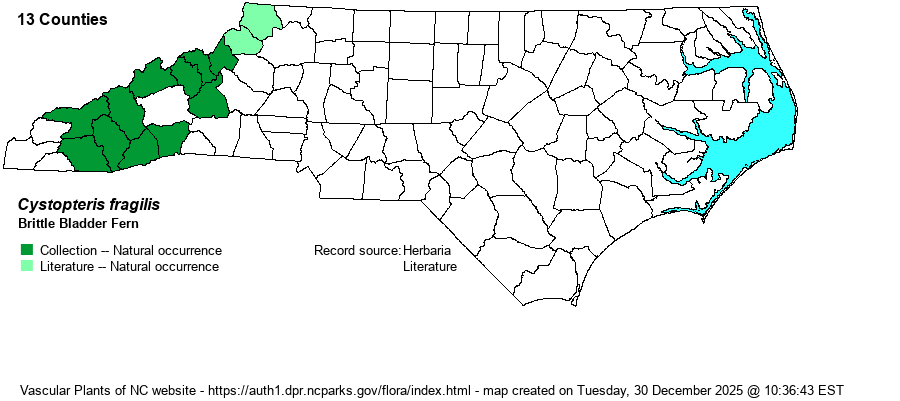| Author | (L.) Bernhardi | |
| Distribution | The distributions of Cystopteris fragilis and C. protrusa are not yet fully resolved in the Mountains of NC. We have mapped those which we feel confident of. Other records will be added as verified specimens come to light. NCNHP lists C. fragilis from only five counties: Ashe, Haywood, Jackson, Mitchell, and Watauga.
This is a Northern species, ranging across much of Canada and south to NJ and AZ, and in the Appalachians south to NC. | |
| Abundance | Not well known. NCNHP give a State Rank of S1, but if the specimen data in SERNEC are reasonably close to correct, it is not overly rare in the mountains, and thus the website editors have recommended a rank of S2?. This is a Significantly Rare species in the state. | |
| Habitat | This is a rock-requisite species, at least in the Appalachians, growing on dry to somewhat dry rocks, such as on cliffs -- mainly at high elevations on exposed sites. Rock types -- mafic vs. felsic -- seem to have been poorly reported in NC. |
| Phenology | Probably fruits from April or May into June. | |
| Identification | This species is very similar to the quite common C. protrusa. Like that species, it has an ovate blade with bipinnate-pinnatifid structure, yielding a quite lacy blade. In this species the leaf blade is longer/narrower than in C. protrusa, being 3-4 times as long as wide versus only 2-2.5 times as long as wide in C. protrusa (and C. tenuis). This species has the pinnae perpendicular to the rachis; the other two have the pinnae angled somewhat toward the apex from the rachis. Also, this species has sharper teeth on the pinnules, as opposed to rounded or crenate margins in the other two. This species grows only on rock outcrops, whereas C. protrusa typically grows in shaded, rich soils, though the rare C. tenuis also grows mostly on rocks. | |
| Taxonomic Comments | This species and C. protrusa have often been lumped as one entity, at least in the past century. For example, RAB (1968) only listed C. protrusa, with C. fragilis and C. tenuis included within it.
| |
| Other Common Name(s) | Common Fragile Fern | |
| State Rank | S1 [S2?] | |
| Global Rank | G5 | |
| State Status | SR-P | |
| US Status | | |
| USACE-agcp | FACU link |
| USACE-emp | FACU link |

